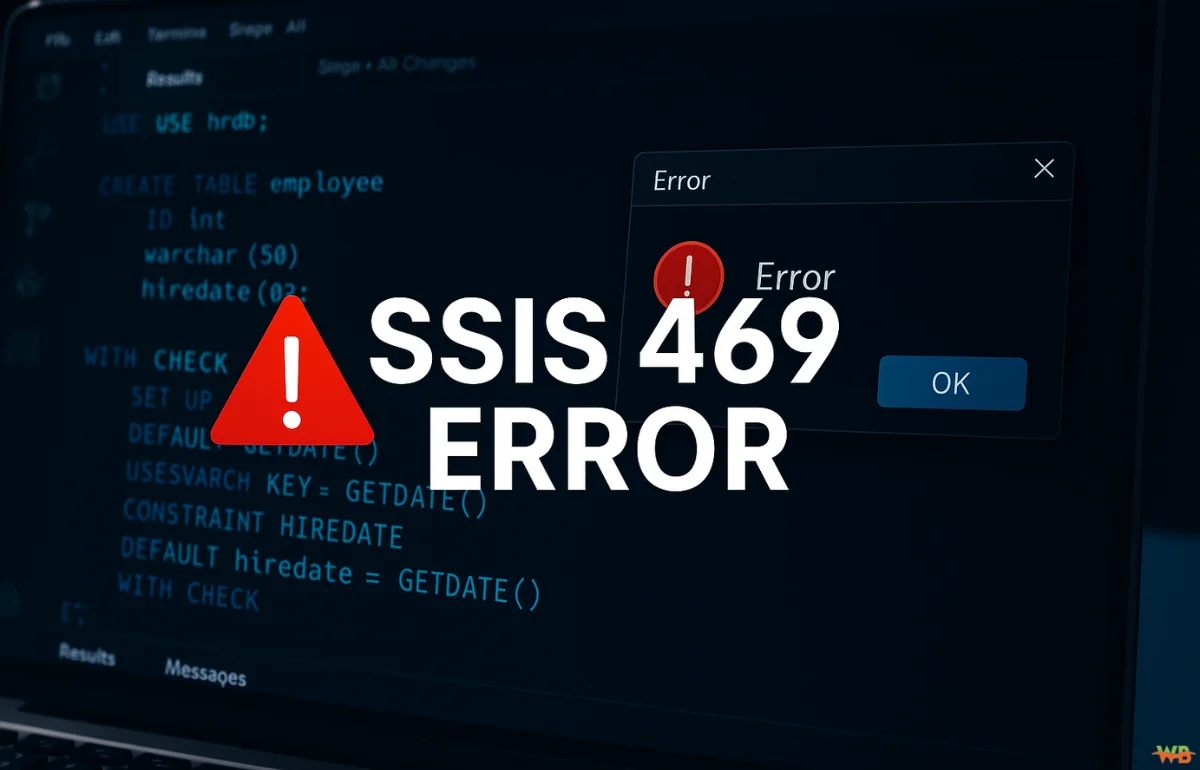SQL Server Integration Services (SSIS) is a powerful tool for handling data movement, transformation, and loading processes. But what happens when your workflow suddenly stops and throws an error code you can’t even find in Microsoft’s documentation? That’s exactly the challenge with SSIS 469. This elusive error code has frustrated many developers due to its vague nature and lack of official reference. In this guide, we’ll break down what SSIS 469 likely means, why it appears, and how you can systematically resolve it.
What Is SSIS 469?
A Hidden Error with Real Consequences
The error SSIS 469 doesn’t exist in Microsoft’s official list of SSIS error codes. Still, developers report encountering it during SSIS package execution, especially when working with script tasks, custom components, or external processes. Because of this ambiguity, SSIS 469 is generally viewed as a generic or masked error — a sign that something deeper is wrong.
Think of it as a catch-all signal. The package knows something failed, but can’t give you specifics. This makes debugging a bit like detective work — but with the right approach, you can get to the bottom of it.
Common Causes of SSIS 469
1. Script Task Failures
Many times, the error pops up during script execution. If you’re using C# or VB.NET inside your SSIS package and the code encounters an unhandled exception, that error might show up as SSIS 469.
How to Fix It:
-
Check for missing null checks or data type mismatches.
-
Wrap risky code blocks in try-catch statements.
-
Enable logging within your script to capture error details.
2. Custom Component Malfunctions
If you’re using a third-party or in-house custom component, SSIS 469 might be masking a failure within that component. Poorly implemented exception handling inside a DLL can cause this.
Solution:
-
Confirm the component supports your SSIS and SQL Server versions.
-
If you have access, look into the component’s source code or documentation.
-
Isolate the task and replace it with a simpler equivalent for testing.
3. Broken Connection Managers
Sometimes, an SSIS package fails to connect to a database, FTP, or API. While SSIS might throw a more specific error normally, issues in downstream tasks might still produce SSIS 469.
Fix Strategy:
-
Recheck all connection strings.
-
Make sure credentials are still valid.
-
Test connectivity using “Test Connection” inside SSIS Designer.
4. Data Conversion Errors
Misalignments between data types (e.g., inserting a string into an integer column) during data transformation can lead to runtime crashes that aren’t always reported clearly.
Recommended Fix:
-
Use data viewers to inspect pipeline data at transformation points.
-
Apply explicit type conversions using Derived Column transformations.
How to Troubleshoot SSIS 469
Fixing SSIS 469 is all about isolation and logging. Here’s a structured method to debug it.
Step 1: Log Everything
Start by enabling SSIS built-in logging. Use the Event Handlers tab and capture events like:
-
OnError
-
OnWarning
-
OnTaskFailed
Log these to a flat file or SQL table to inspect what happened before the error occurred.
Step 2: Use Breakpoints
In SSIS Designer, apply breakpoints to suspected tasks. Step through execution to see where things go off the rails.
Step 3: Simplify the Package
Try disabling portions of your package to narrow down where ssis 469 occurs. Once isolated, dig deeper into that component or task.
Table: Quick Reference for SSIS 469 Troubleshooting
| Component Affected | Possible Issue | Suggested Fix |
|---|---|---|
| Script Task | Unhandled exception, type mismatch | Use try-catch, log errors, step through debugger |
| Custom Component | Version mismatch or internal bug | Contact vendor, verify compatibility |
| Connection Manager | Incorrect credentials or bad string | Retest connections, update login details |
| Data Flow Task | Conversion errors | Use data viewers, validate column mappings |
| Execute Process Task | External process failed silently | Run process manually, check logs |
How Resource Constraints Contribute to SSIS 469
SSIS is resource-intensive, especially during large ETL processes. A low-memory or CPU-starved environment can cause instability that results in vague errors like SSIS 469.
What to Monitor:
-
Disk I/O spikes
-
RAM availability
-
CPU load
Use Windows Performance Monitor or SQL Server Profiler to track these metrics during execution.
Real-World Example
A financial services firm reported SSIS 469 during an overnight ETL job. After two weeks of trial and error, the root cause turned out to be a script task attempting to access a web API that occasionally timed out. No exception was handled, and the error bubble-wrapped as SSIS 469.
Solution: The developer wrapped the HTTP call in a try-catch block, logged errors to a flat file, and configured retries. Problem solved.
Best Practices to Prevent SSIS 469
-
Always use structured error handling in script components.
-
Keep custom components updated and tested after SSIS upgrades.
-
Log critical steps and values throughout your packages.
-
Avoid overloading servers — schedule jobs based on resource patterns.
-
Test external processes outside SSIS before integrating.
Frequently Asked Questions (FAQs)
[rank_math_rich_snippet id=”s-9b79fc1b-a834-414a-8716-6f0c8dd6ef4b”]
Conclusion: Don’t Let SSIS 469 Derail Your Workflow
The SSIS 469 error may be frustrating, but it’s not unbeatable. By approaching it like a systems analyst — checking scripts, custom code, connectivity, and resources — you can almost always find the root cause. Stay methodical, log everything, and leverage community resources to troubleshoot effectively.
Next Step: If you’re frequently facing issues with SSIS packages, consider building a central logging and error tracking framework in your ETL infrastructure. This proactive approach can help you spot and resolve issues faster, long before error codes like SSIS 469 make an appearance.
Citations:
-
Microsoft Learn. “Integration Services (SSIS) Documentation.” https://learn.microsoft.com/en-us/sql/integration-services/
-
Stack Overflow. Various threads. https://stackoverflow.com/questions/tagged/ssis
-
SQL Server Central. Community forums and troubleshooting advice. https://www.sqlservercentral.com/

Ton Roobprom is an experienced writer focused on practical advice across technology, business, travel, beauty, lifestyle, and home improvements. He specializes in distilling complex subjects into clear, actionable insights to help you enhance your daily life.


